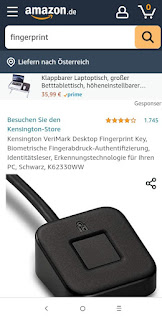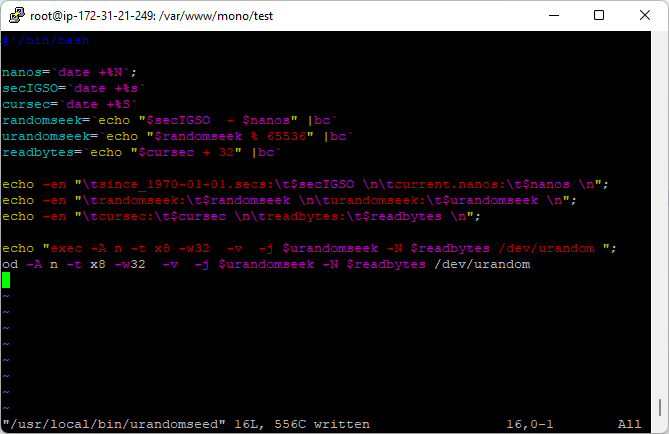Application settings example:
BaseSets for basic settings as abstract singelton base
using System;using System.Reflection;namespace work.darkstar.blog{/// <summary>/// abstract class BaseSets/// </summary>[Serializable]public abstract class BaseSets{public string AssemblyName { get => Assembly.GetExecutingAssembly().GetName().ToString(); }public string Copyright { get => "GNU LIGHT GENERAL PUBLIC LICENSE 2.0 LGPL"; }public virtual string AssemblyCom { get => "darkstar.work"; }public virtual int AppId { get; protected set; }public virtual string AppName { get; protected set; }/// <summary>/// protected empty constructor for inheritable singelton/// </summary>protected BaseSets() { }/// <summary>/// protected parameterized constructor for inheritable singelton/// </summary>protected BaseSets(int appId, string appName){AppId = appId; AppName = appName;}}}
AppSets for application settings as instancable singelton default app sets (settings):
using Microsoft.Win32;
using System;
using System.Reflection;
using System.Windows.Forms;
namespace work.darkstar.blog
{ public interface IAppSetsDomain : IAppDomainSetup { System.AppDomain AppCurrentDomain { get; } } /// <summary>
/// application settings singelton /// </summary>
[Serializable] public class AppSets : BaseSets, IAppDomainSetup
{
private static AppSets _appSets; private static object _initLock, _sndLock;
protected static AppSets DoubleLockInstance { get { _sndLock = new System.Object(); lock (_sndLock) { if (_initLock != null) _initLock = null;
if (_initLock == null) _initLock = new System.Object(); lock (_initLock) { if (_appSets == null) _appSets = new AppSets(); } return _appSets; } } } public string CodeBase { get => Assembly.GetExecutingAssembly().CodeBase; }
public string BaseDirectory { get => AppDomain.CurrentDomain.BaseDirectory; } public string AppDataPath { get => Application.CommonAppDataPath; } public RegistryKey AppDataRegistry { get => Application.CommonAppDataRegistry; }
#region implementing interface IAppSetsDomain, IAppDomainSetup public AppDomain AppCurrentDomain { get => AppDomain.CurrentDomain; } public string ApplicationBase { get ; set; } public string ApplicationName{ get ; set; }
public string CachePath{ get ; set; } public string ConfigurationFile{ get ; set; }
public string DynamicBase { get ; set; }
public string LicenseFile { get ; set; }
public string PrivateBinPath { get ; set; }
public string PrivateBinPathProbe { get ; set; }
public string ShadowCopyDirectories { get ; set; }
public string [] ShadowCopyDirectoryArray {
get => ShadowCopyDirectories.Split(';'); } public bool FilesShadowCopy { get ; set; } public string ShadowCopyFiles { get => FilesShadowCopy.ToString().ToLower(); set { FilesShadowCopy = Boolean.Parse(value); } } public bool FilesShadowCopy{ get ; set; } public string ShadowCopyFiles{ get => FilesShadowCopy.ToString() ; set; } #endregion implementing interface IAppSetsDomain, IAppDomainSetup
/// <summary> /// static constructor /// </summary> static AppSets() {
_initLock = new System.Object();
lock (_initLock) { _appSets = new AppSets(); }
}
/// <summary> /// private empty constructor /// </summary> private AppSets() { AppId = AppDomain.CurrentDomain.Id; AppName = Assembly.GetExecutingAssembly().FullName; }
/// <summary> /// protected parameter constructor /// </summary> protected AppSets(int appId, string appName) : base(appId, appName) { }
}}Sealed MyAppSets for application specialized appSets as Lazy<T> singelton:
using System;
using System.IO; using System.Security;/* ... */using Microsoft.Win32;/* ... */using Windows.Forms;namespace work.darkstar.blog { /// <summary> /// my application settings singelton /// </summary> [Serializable] public sealed class MyAppSets : AppSets { /// <summary> /// private static readonly Lazy<T> self containing private real singelton unique instance /// </summary> private static readonly Lazy<MyAppSets> _instance = new Lazy<MyAppSets>(() => new MyAppSets(AppDomain.CurrentDomain.Id, "LazyApp")); /// <summary> /// static instance getter for Singeltion /// </summary> public static MyAppSets Instance { get => _instance.Value; } public string UserAppDataPath { get => Application.UserAppDataPath; } public RegistryKey UserAppDataRegistry { get => Application.UserAppDataRegistry; } /// <summary> /// private constructor with partameters for sealed unique singelton /// </summary> private MyAppSets(int appId, string appName) : base(appId, appName) { } /// <summary> /// Gets name value pair for application registry key saved in registry scope for current user /// </summary> /// <param name="regName">registry name identifier</param> /// <param name="subKey">subKey in scope of current user</param> /// <returns>object value</returns> /// <exception cref="ApplicationException">application exception with detailed inner exception</exception> public object GetUserRegValuey(string regName, string subKey = null) { object o = null; RegistryKey key = null; Exception ex = null; try { key = (subKey == null) ? UserAppDataRegistry : UserAppDataRegistry.OpenSubKey(subKey, false); o = key.GetValue(regName); } catch (SecurityException sex) { ex = sex; } catch (ObjectDisposedException odEx) { ex = odEx; } catch (UnauthorizedAccessException uaEx) { ex = uaEx; } catch (IOException ioeEx) { ex = ioeEx; } finally { if (key != null && subKey != null) key.Close(); if (ex != null) throw (new ApplicationException("Error accessing registy key: " + $"{UserAppDataRegistry}\t name: {regName}\t subkey: {subKey}", ex));} return o; } /// <summary> /// Set Value for UserAppDataRegistry /// </summary> /// <param name="regName">registry name </param> /// <param name="value"value to set></param> /// <param name="subKey">subKey</param> /// <returns>void means nothing</returns> /// <exception cref="ApplicationException">application exception with detailed inner exception</exception> public void SetUserReg(string regName, object value, string subKey = null) { RegistryKey key = null; Exception ex = null; try { key = (subKey == null) ? UserAppDataRegistry : UserAppDataRegistry.OpenSubKey(subKey, true); key.SetValue(regName, value); } catch (Exception anyEx) { ex = new ApplicationException($"Error setting value=" + $"{value} for name={regName} inside registry key: {key.Name}", anyEx); } finally { if (key != null && subKey != null) key.Close(); if (ex != null) throw ex; } } } }
Accessing MyAppSets singelton inside any entity, framework, helper, [...] class
using System; /* ... */
using work.darkstar.blog;
public class MyEntity : IAppSetsDomain {
/* [ ... ] */
/* [Inject] */
/* [ ... ] */
public AppDomain AppCurrentDomain {
get => MyAppSets.Instance.AppCurrentDomain;
set => MyAppSets.Instance.AppCurrentDomain = value;
}
/* ... */
}









